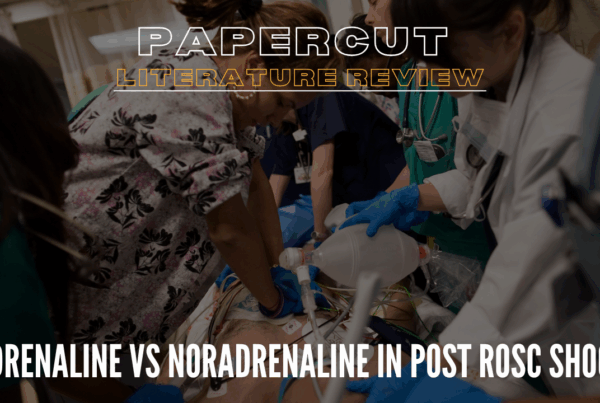Let’s face it, everyone’s nervous about the new exam. What’s different, what isn’t?
Everything is different, yet nothing is. The syllabus is still the same. The knowledge you need to have to practice as an Emergency Physician is still the same! But this is an exam that relies less on technique….sure there’s still some technique in it, however you now need to display knowledge
To me, the MCQ’s will actually be a little harder as they are based around clinical scenarios that rely on significant knowledge. The EMQ’s will confuse people, but they are simplest of all and the SAQ’s,…… well, I call the old VAQ’s with a twist.
Practice some simple questions below, our group put together at the FACE to FACE course in Melbourne recently.
6 months of great learning. A bank of 100’s and 100’s of questions!
Get that exam! Good luck everyone!
Try some questions below:
MCQ
1. A 2yo boy presents with 6 hours of being irritable and “breathless”. On examination the child is alert and well perfused with SaO2=100% on air. His ECG shows SVT at a rate of 210.( 1 point)
The appropriate choice of medications is:
(a)Adenosine 100mcg/kg rapid IV bolus, if unsuccessful repeat doses may be given increasing by 100mcg /kg every 2 minutes (maximum 12 mg).
(b)Adenosine 10mcg/kg rapid IV bolus, if unsuccessful repeat doses may be given increasing by 10mcg /kg every 2 minutes (maximum 4 doses)
(c)Adenosine 250mcg/kg rapid IV bolus, if unsuccessful repeat doses may be given increasing by 250mcg /kg every 2 minutes (maximum 4 doses)
(d)Adenosine 25 mcg/kg rapid IV bolus, if unsuccessful repeat doses may be given increasing by 25mcg /kg every 2 minutes (maximum 6mg)
2. A six year old boy presents with upper respiratory symptoms and haematuria. He does not have any rash and looks otherwise quite well. Dipstick is positive for blood and protein.
The most likely diagnosis is:(1 point)
(a)Post-streptococcal glomerulonephritis
(b)IgA nephropathy
(c)Haemolytic-uraemic syndrome
(d)Henoch-Schonlein purpura
3 A 34/M patient is brought to your ED after a fall from a ladder. He was seen to have hit his head on a concrete step. He had a loss of consciousness for 2 minutes but no palpable skull fracture. He is opening eyes to voice and confused with time and place for the last 1 hour. He is able to follow commands. What is his neurotrauma severity?( 1 point)
(a)Minimal
(b)Mild
(c)Moderate
(d)Severe
4 A 5year old girl fell off a trampoline and complains of neck pain. Your intern has ordered an X-ray of her C-spine and asks you to review the film. Which of these findings is considered a normal variant of the paediatric c-spine? (1 point)
(a)Incomplete ossification of the posterior arch of C2
(b)Persistence of synchondrosis at the base of the odontoid
(c)Pseudosubluxation of C1 on C2
(d)Anterior wedging of the vertebral bodies of up to 5 mm
EMQ 1
Malaria Sickle cell disease Gilbert’s Syndrome Viral hepatitis Drug-induced hepatitis
Autoimmune hepatitis Amanita mushroom poisoning Alcoholic hepatitis
Cholangitis Cholelithiasis Primary biliary cirrhosis
(a)A obese 25 yo woman with a past history of borderline PD and depression presents with jaundice and RUQ pain but no peritonism. Her LFTs are as follows:(1 point)
Hb =104 WCC=15.5 Plt =230 Bilirubin=98 ALP =104 AST =1516 ALT =780 INR=1.1
(b)A obese 40 yo woman presents with acute RUQ pain and tenderness but no peritonism. Her LFTs are as follows:(1 point)
Hb =132 WCC=11.4 Plt=230 Bilirubin=40 ALP =400 AST= 60 ALT = 56 INR =1.1
EMQ 2
a. Idiopathic Arthritis
b. Transient Synovitis
c Leg-Calves Perthes
d. Slipped Upper Femoral Epiphyses
e Osteomyelitis
f Septic Arthritis
(a) An 11 year-old boy is brought in by his parents with a R-sided limp for the past 3 days after doing exercises to lose weight. He has an antalgic gait and a painful R knee. His affected leg appears short, held in flexion and external rotation. He is otherwise well.( 1 point)
(b) A 3-year old girl presents with pain on walking. She has had a recent viral URTI with mild to moderate reduction in hip movement in internal rotation. The child appears otherwise well.( 1 point)
(c) A 6 year old boy presents with a 3 week history of a limp, antalgic gait and pain to the L knee. Examination of his hip shows internal rotation and extension to be more painful. He has unequal leg lengths.(1 point)
(d) A 3-year old girl is brought in for refusing to weight-bear. She is guarding her R leg from being moved. She is febrile to 38.5. Her R hip joint is tender to touch and the child screams when you attempt to range the hip.(1 point)
How did you go?
These are simple and straightforward questions you should be getting a 7/10 minimum
scroll down for the answers
ANSWERS
MCQs
1 a 2 b 3 c 4b
EMQs
1a cholangitis
1b cholelithiasis
2a d 2b d 2c c 2d f










